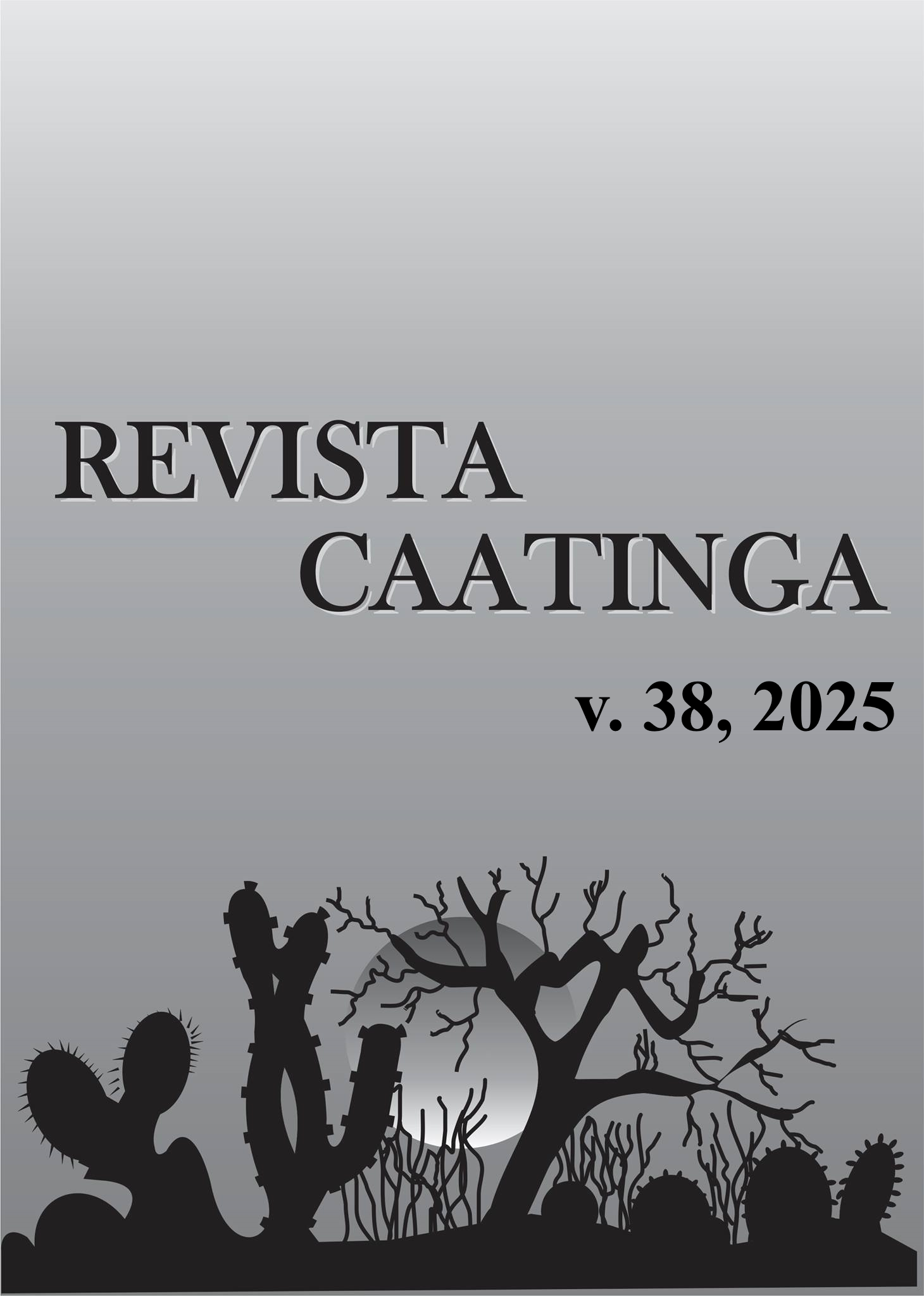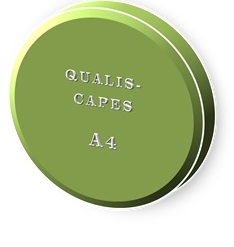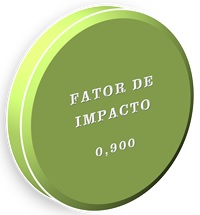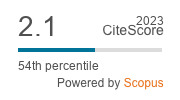Morphophysiological aspects of eggplant grown under irrigation with brackish water and foliar application of chitosan
DOI:
https://doi.org/10.1590/1983-21252025v3812786rcKeywords:
Solanum melongena L.. Salt stress. Biopolymers. Elicitors.Abstract
The aim of this study was to evaluate the morphophysiological aspects of eggplant cv. Preta Comprida irrigated with brackish water and subjected to foliar application of chitosan. Treatments consisted of five levels of electrical conductivity of irrigation water - ECw (0.4; 1.4; 2.4; 3.4 and 4.4 dS m-1) and two concentrations of chitosan (0 and 0.50 g L-1), arranged in randomized blocks, in a 5 × 2 factorial scheme with four replicates. Relative water content, electrolyte leakage, chlorophyll a, chlorophyll b and total chlorophyll contents and carotenoid contents, initial fluorescence, maximum fluorescence, variable fluorescence and quantum efficiency of photosystem II were evaluated. Growth was evaluated by relative growth rates in plant height and stem diameter. Chitosan application attenuated the effects of salt stress on relative water content up to the estimated ECw of 1.9 dS m-1. Foliar application of chitosan at a concentration of 0.50 g L-1 promoted beneficial effects on the synthesis of chlorophyll a, total chlorophyll and carotenoids in eggplant grown under water salinity of 0.4 dS m-1. Irrigation water salinity above 0.8 dS m-1 increased electrolyte leakage and inhibited the synthesis of photosynthetic pigments and chlorophyll a fluorescence in eggplant, regardless of foliar application of chitosan. Chitosan promoted a higher growth rate in height of eggplant in the period of 58-85 days after sowing.
Downloads
References
ALKHATIB, R. et al. Photosynthetic and Ultrastructural Properties of Eggplant (Solanum melongena) under Salinity Stress. Horticulturae, 7: 181, 2021.
ALMEIDA, L. G. et al. Root system in maize plants cultivated under water deficit and application of chitosan. Revista Brasileira de Milho e Sorgo, 19: 11-11, 2020.
ARNON, D. I. Copper enzymes in isolated chloroplasts: Polyphenoloxidase in Beta vulgaris. Plant Physiology, 24: 1-15, 1949.
BAKHOUM, G. S.; SADAK, M. S.; BADR, E. A. E. M. Mitigation of adverse effects of salinity stress on sunflower plant (Helianthus annuus L.) by exogenous application of chitosan. Bulletin of the National Research Centre, 44: 1-11, 2020.
BENINCASA, M. M. P. Análise de crescimento de plantas: noções básicas. Jaboticabal, SP: FUNEP, 2003. 41 p.
DIAS, A. S. et al. Gas exchanges, quantum yield and photosynthetic pigments of west Indian cherry under salt stress and potassium fertilization. Revista Caatinga, 32: 429-439, 2019.
ELSHARKAWY, M. M. et al. Mechanism of wheat leaf rust control using chitosan nanoparticles and salicylic acid. Journal of Fungi, 8: 304, 2022.
GOHARI, G. et al. Mitigation of salinity impact in spearmint plants through the application of engineered chitosan-melatonin nanoparticles. International Journal of Biological Macromolecules, 224: 893-907, 2023.
HASSAN, F. A. S. et al. Chitosan nanoparticles effectively combat salinity stress by enhancing antioxidant activity and alkaloid biosynthesis in Catharanthus roseus (L.) G. Don. Plant Physiology and Biochemistry, 162: 291-300, 2021.
IBGE - Instituto Brasileiro de Geografia e Estatística. Pesquisa de orçamentos familiares, dados demográficos e produção agrícola nacional, 2022. 2022. Available at: <http://www.sidra.ibge.gov.br>. Access on: Mar. 24, 2024.
LIMA, G. S. et al. NPK accumulation, physiology, and production of sour passion fruit under salt stress irrigated with brackish water in the phenological stages and k fertilization. Plants, 12: e1573, 2023.
MONTEIRO, D. R. et al. Chlorophyll a fluorescence in saccharine sorghum irrigated with saline water. Revista Brasileira de Engenharia Agrícola e Ambiental, 22: 673-678, 2018.
NOVAIS, R. D.; NEVES, J. C. L.; BARROS, N. D. Ensaio em ambiente controlado. In: OLIVEIRA, A. J., et al. (Eds.). Métodos de pesquisa em fertilidade do solo. Brasília, DF: EMBRAPA, 1991. v. 1, cap. 2, p. 89-253.
OLIVEIRA, W. J. et al. Fluorescência da clorofila como indicador de estresse salino em feijão caupi. Revista Brasileira de Agricultura Irrigada, 12: 2592-2603, 2018.
R CORE TEAM. R: A language and environment for statistical computing. Available at: <http://www.rproject.org/>. Access on: Sep. 10, 2024.
RAMOS, J. G. et al. Saline water irrigation and foliar application of H2O2 change ionic homeostasis of sour passion fruit. Revista Caatinga, 37: e12122, 2024.
RICHARDS, L. A. Diagnosis and improvement of saline and alkali soils. Washington: U.S, Department of Agriculture. 1954. 160 p.
ROQUE, I. A. et al. Biomass, gas exchange and production of cherry tomato cultivated under saline water and nitrogen fertilization. Revista Caatinga, 35: 686-696, 2022.
SCOTTI-CAMPOS, P. et al. Physiological responses and membrane integrity in three Vigna genotypes with contrasting drought tolerance. Emirates Journal of Food and Agriculture, 25: 1002-1013, 2013.
SHUMILINA, J. et al. Glycation of plant proteins: regulatory roles and interplay with sugar signalling?. International journal of molecular sciences, 20: 2366, 2019.
SILVA, A. A. et al. Salicylic acid improves physiological indicators of soursop irrigated with saline water. Revista Brasileira de Engenharia Agrícola e Ambiental, 26: 412-419, 2022.
SILVA, A. A. et al. Salicylic acid relieves the effect of saline stress on soursop morphysiology. Ciência e Agrotecnologia, 45: e007021, 2021.
SILVA, A. R. A. et al. Pigmentos fotossintéticos e potencial hídrico foliar em plantas jovens de coqueiro sob estresses hídrico e salino. Revista Agro@mbiente On-line, 10: 317-325, 2017.
SONG, L. et al. Exogenous melatonin improves the chilling tolerance and preharvest fruit shelf life in eggplant by affecting ROS-and senescence-related processes. Horticultural Plant Journal, 9: 523-540, 2023.
TEIXEIRA, P. C. et al. Manual de métodos de análise de solo. 3. ed. Brasília, DF: EMBRAPA. 2017. 577 p.
ULLAH, N. et al. Mitigation the adverse effect of salinity stress on the performance of the tomato crop by exogenous application of chitosan. Bulletin of the National Research Centre, 44: 1-11, 2020.
WEATHERLEY, P. E. Studies in the water relations of the cotton plant. I. The field measurement of water deficits in leaves. The New Phytologist, 49: 81-97, 1950.
XAVIER, A. V. O. et al. Salicylic acid alleviates salt stress on guava plant physiology during rootstock formation. Revista Brasileira de Engenharia Agrícola e Ambiental, 26: 855-862, 2022.
YOUSEFZADEH, S. et al. Effects of ecological agriculture approaches on dragonhead (Dracocephalum moldavica L.) productivity and oil yield. Arabian Journal of Geosciences, 16: 373, 2023.
YUDINA, L. et al. lightinduced decrease in the photochemical reflectance index (PRI) can be used to estimate the energy-dependent component of non-photochemical quenching under heat stress and soil drought in pea, wheat, and pumpkin. Photosynthesis Research, 146: 175-187, 2020.
Downloads
Published
Issue
Section
License
Os Autores que publicam na Revista Caatinga concordam com os seguintes termos:
a) Os Autores mantêm os direitos autorais e concedem à revista o direito de primeira publicação, com o trabalho simultaneamente licenciado sob a Licença Creative Commons do tipo atribuição CC-BY, para todo o conteúdo do periódico, exceto onde estiver identificado, que permite o compartilhamento do trabalho com reconhecimento da autoria e publicação inicial nesta revista, sem fins comerciais.
b) Os Autores têm autorização para distribuição não-exclusiva da versão do trabalho publicada nesta revista (ex.: publicar em repositório institucional ou como capítulo de livro), com reconhecimento de autoria e publicação inicial nesta revista.
c) Os Autores têm permissão e são estimulados a publicar e distribuir seu trabalho online (ex.: em repositórios institucionais ou na sua página pessoal) a qualquer ponto antes ou durante o processo editorial, já que isso pode gerar alterações produtivas, bem como aumentar o impacto e a citação do trabalho publicado (Veja O Efeito do Acesso Livre).







